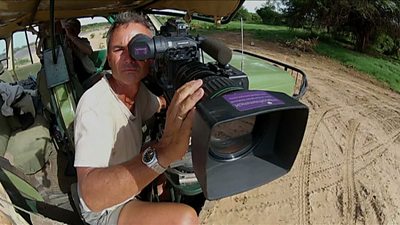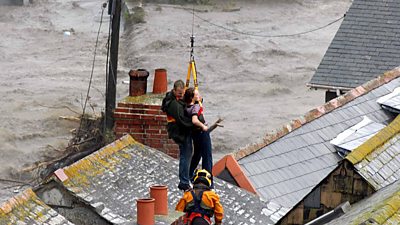How can I protect my camera in extreme weather conditions?
A 91�ȱ� Academy guide on how to protect your video camera in extreme weather conditions like heat, cold, moisture and dust
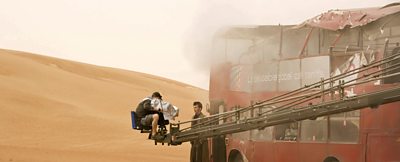
Presented By
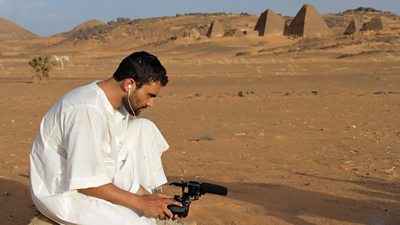 Presented by Ash Bhardwaj - Adventure Film Maker
Presented by Ash Bhardwaj - Adventure Film Maker
Introduction
Filming in extreme weather conditions can be exciting for you but hazardous for your camera.
We explain what to look out for when faced with extreme heat, cold, moisture or dust. Discover what can happen to your camera - and how to prevent problems.
What do I need to consider?
In this video, adventure film-maker Ash Bhardwaj shares what you need to anticipate when using your camera in extreme environments. You'll also discover what weather conditions and damage 91�ȱ� camera operators have confronted while on shoots.
What damage can occur?
Learn about types of damage that can occur to your camera in extreme weather conditions.

- Plastic can freeze and break in cold conditions.
- Moving parts (like the focus ring) can get jammed with dust or sand particles.
- Grips can grow mildew and fungus if left in warm, moist environments.
- In cold weather, cables can become brittle and break.
- Cable insulation can snap off in the cold.
- If snow gets into the end of a cable, it can compress into ice and prevent a connection when you try to plug it in.
- In cold temperatures, LCDs may lose contrast, display screen information more slowly or change color when touched.
- Below -25C, the LCD panel can freeze and crack.
- Dust and sand particles can jam the inside of memory card slots, any 'door' that opens to a port on the camera body, or any open port (such as a microphone port).
- Moisture in the battery port can corrode the electrical contacts.
- Scratches from blowing dust or sand particles.
- Condensation can damage the image sensor and fog up camera mirrors.
- Moisture can freeze on to the glass.
- Changing lenses outdoors can get moisture or dust particles inside the camera body.
- Exposure to prolonged direct sunlight can damage internal sensors.
- Prolonged moisture on internal mechanical parts can cause rust.
How can I protect my camera?
Tips to keep your camera safe when filming in extreme weather conditions.
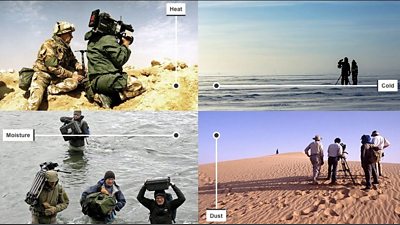
- Heat Keep your camera as cool as possible. Keep it out of direct sunlight and use an umbrella or makeshift shade.
- Use an insulated camera bag when transporting it. Don’t leave your camera inside a hot vehicle, and protect it with something like a white towel when not in use.
- In temperatures of more than 38 degrees, give the camera periodic rests in an air-conditioned environment.
- Elements such as the batteries, image sensors and LCD screen can easily overheat. Use an AC adapter kit and limit your use of the LCD by using an external monitor or the viewfinder.
- Cold Bring an extra set of fully charged batteries as the cold will quickly drain their power. Chemical hand-warmers can be used around the batteries in the camera, as well as for the extras in a bag. You can also use hand-warmers in the camera bag when you’re outside but not using the camera.
- Look into special cold-weather cables that won’t become brittle and snap, and polar jackets to protect the camera from snow and rain.
- Put the camera and lenses inside sealed plastic bags when the air outside is cold before bringing them into a heated environment. This allows them to warm up slowly and prevents condensation. Add silica gel desiccant packets to the bags to help remove any moisture.
- Use a rain jacket or underwater camera housing.
- Bring a chamois lens cleaners to wipe off any moisture.
- Use an insulated camera bag, and put silica packets in it.
- Minimise lens changes.
- When in a humid environment, keep the camera in an non-air-conditioned room or allow it to warm up for as long as possible before using it.
- Use UV filters to protect the lens from scratches.
- Use compressed air and soft brushes to remove dust and particles from the camera body every day you are shooting in that environment.
- In extremely windy/dusty locations, consider using underwater camera housing.
- Change lenses and memory cards in a protected area (vehicle, indoors) or inside a plastic bag.
Final things to remember?
From high-budget drama to no-budget documentaries, extreme weather conditions can arise almost anywhere. Keep these tips in mind when taking your camera to the unpredictable outdoors.
Cameraman John Shier filming a grass fire in Brazil’s cerrado
Smoke contains fine particles which can not only make your lens dirty but stick to components inside the camera.
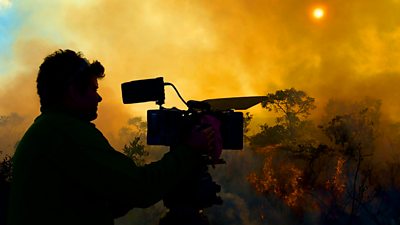
War and Peace: 2016: Production shot
Snowflakes melting on to your camera can cause condensation, which can re-freeze and damage the electronics when going back into the cold.
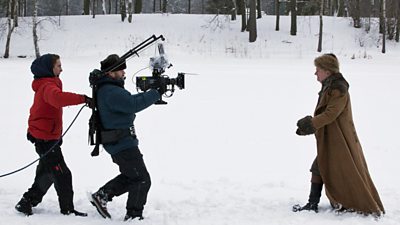
One of Us: Ep1: The Storm: Production shot
Even if the weather report promises clear skies, remember to always take a rain cover for your camera if there is even a tiny chance it could rain.
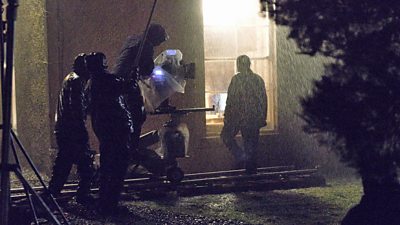
Sue Gibson films Bedouin nomads sharing coffee around campfire at dawn.
The inside of your camera can get hotter than the outside temperature, so keep heat-generating functions like batteries and the LCD screen to a minimum in hot environments.
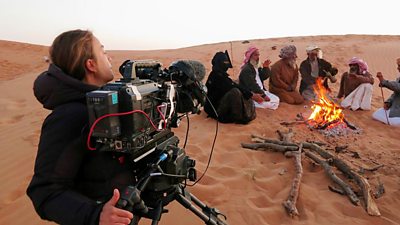
Ash from volcanoes or fires can get into ports or openings and prevent cables from connecting or memory cards from working.
Ash from volcanoes or fires can get into ports or openings and prevent cables from connecting or memory cards from working.
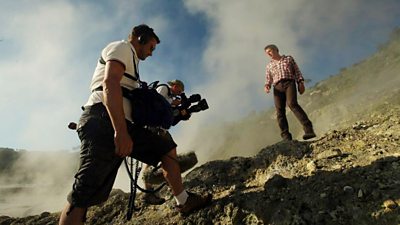
"My Mother and Other Strangers" filming in N.Ireland
Fog and mist can condense into damaging water droplets when you take your camera from a cool to a warm environment. Use cleaning cloths constantly while filming, and silica packets when it’s in the bag.
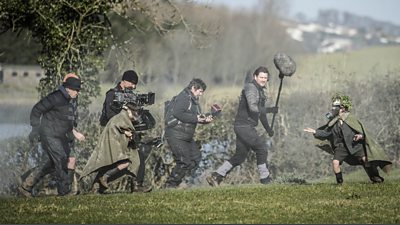
SAS Jungle : Are You Tough Enough? *production shot
When in a humid environment be aware of the Dew Point Temperature (the temperature at which water vapour in the air condenses) and store your camera at or above that temperature.

Genghis Khan production shot 2004
Dust storms can suddenly arise in dry areas, so be prepared with cleaning brushes and lens protectors.


